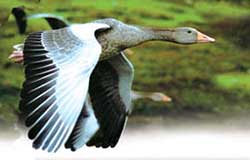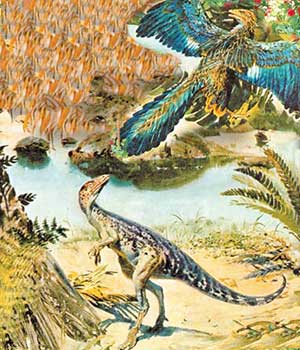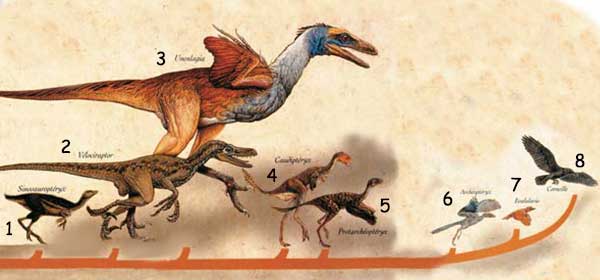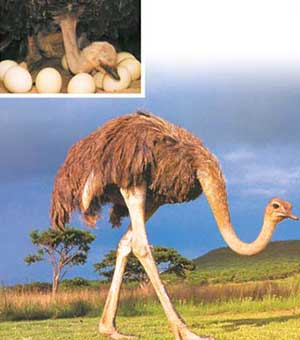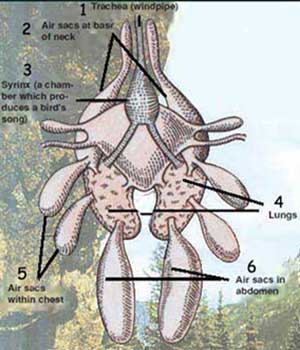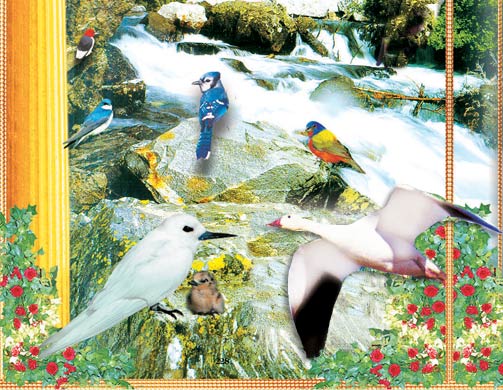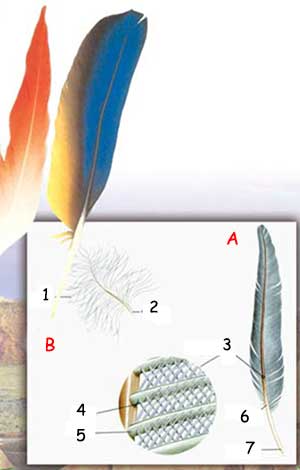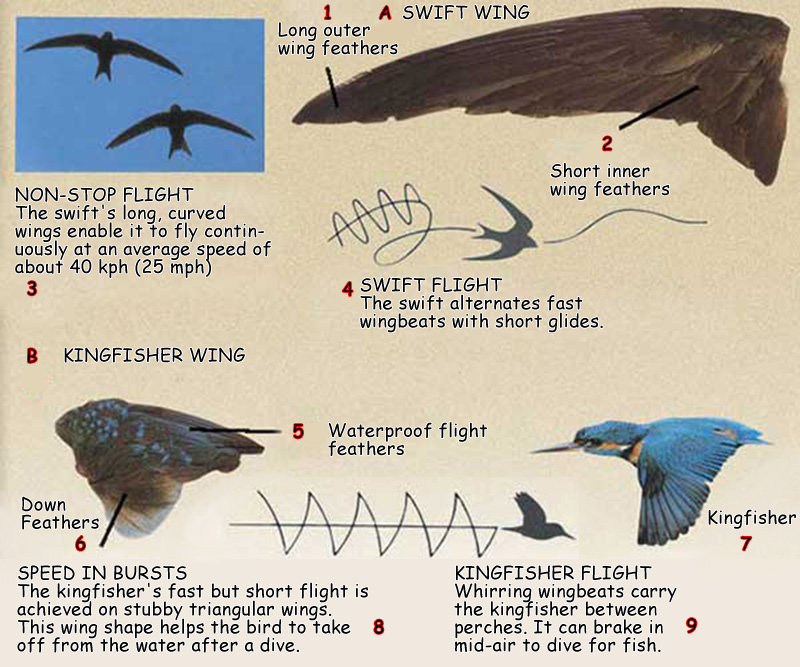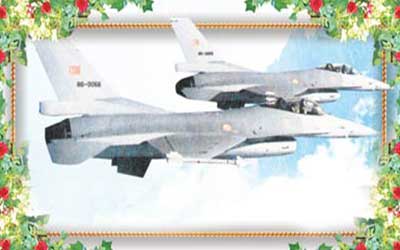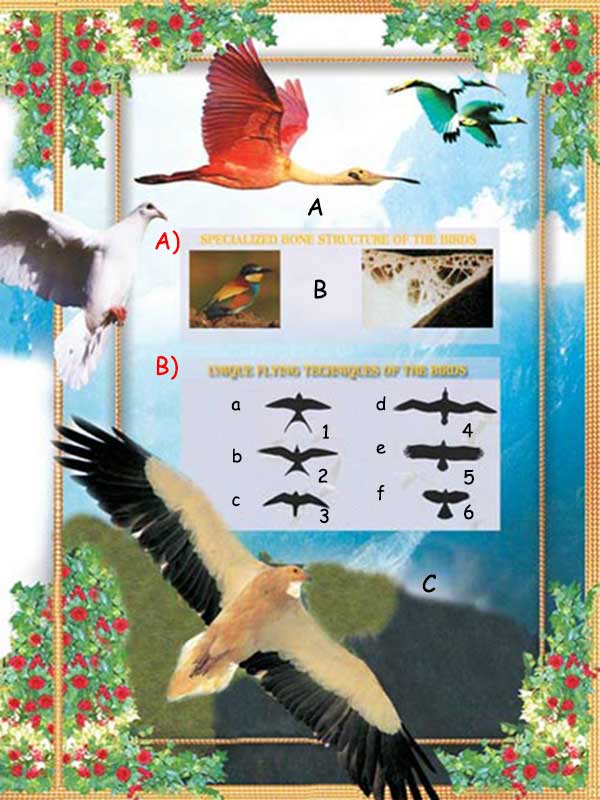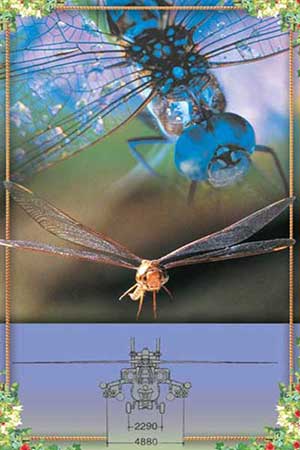Bigotry: The Dark Danger
A Definitive Reply to Evolutionist Propaganda

DOWNLOAD THE BOOK
CHAPTERS OF THE BOOK
- Introduction
- A Series of Blunders Regarding Monkey Intelligence
- The Smuggling Incident National Geographic TV Declined To Cover
- National Geographic TV's Undersea Fairy Tales
- Tall Tales From The National Geographic Channel
- Tales of Transformation from National Geographic Television
- The “Mitochondrial Eve” Deception On The Discovery Channel
- The Dino-Bird Fantasy On The Discovery Channel
- Errors Concerning Human Intelligence From The Discovery Channel
- The Discovery Channel's Spider Dilemma
- Evolutionst Propaganda on The History Channel
- The History Channel's Darwinist and Atheist Propaganda
- New Scientist’s Latest Myth:"Hiccups are a Legacy from Evolution"
- New Scientist’s “ Evolution with Climate” Error
- Paul Davies' Desperate Case for a “Multiverse”
- Evolutionary Tall Tales From The BBC -I-
- Evolutionary Tall Tales From The BBC –II-
- Evolutionary Tall Tales From The BBC –III-
- The BBC's Functionless Tissue Error In Its Documentary The Human Body
- BBC's Evolution of The Human Brain Error
- The Evolutionist Deceptions in the Documentary the Shape of Life
- Evolutionist Deceptions Continue with the Arthropods in the Shape of Life Documentary
- The Evolutionists are Still Struggling with the Same Dilemma: The Origin of Flight
- New Fossil Fish Discoveries Pose a New Dilemma for the Theory of Evolution
- The Latest Version of Baseless Evolutionist Scenarios in Scientific American: Nutrition
- Time Writer M. Lemonick's Mind-Body Error
< <
23 / total: 26
The Evolutionists are Still Struggling with the Same Dilemma: The Origin of Flight
The dino-bird myth once again entered the agenda in an article titled "Wing Assisted Incline Running and the Origin of Flight" in the January 17, 2003, edition of the journal Science. A biologist by the name of Kenneth P. Dial, from the University of Montana, offered a new interpretation of the theory that dinosaurs evolved into birds. His claim was widely reported in the world press, although he offered not one concrete, scientific piece of evidence to support the thesis that birds evolved from dinosaurs. Dial's claim came nowhere near accounting for the complex design in birds, and did not go beyond providing a new story for the dino-bird myth. This article will reveal the scientific deceptions in Kenneth Dial's evolutionist claims by describing the fossil discoveries and the complex design upon which flight is based. Dial's Research
Dial's claim rests on certain observations of the Alectoris chukar species of partridge. One feature of these birds is that they prefer to run up a steep incline or tree trunk rather than fly. As they run, they also flap their wings to gain speed. This short-distance running was given the name Wing-Assisted Incline Running (WAIR). During WAIR, as the partridges run up the slope, they both use their feet and flap their wings, thus reducing the effect of gravity. Their feet are designed in such a way as to cling to the ground, and their wings function like the ailerons on a racing car. As a result of Dial's research, he observed that chicks possessed almost the same WAIR ability as adult birds. He described how within four days of hatching birds were able to climb up 45 degree inclines in this manner, and that their still-growing wings had an aerodynamic effect during this sprint. A number of experiments were conducted on these developing wings, and Dial saw that the aerodynamic effect on wings with shortened feathers decreased. Birds with trimmed feathers were unable to climb as well as birds whose feathers had not been trimmed.
Dial, an evolutionist, maintains that the origin of birds goes back to dinosaurs of the theropod subgroup. He favors the idea that dinosaurs are the ancestors of birds and tries to place his observations of the partridge uphill sprint somewhere into the illusory dino-bird evolution. According to the scenario he came up with, dinosaurs trying to escape from predators flapped their forearms when running on inclines in order to gain speed, and these forearms thus gradually turned into wings. This scenario is totally devoid of any scientific foundation, although he sought to use it as evidence for the imaginary transition from dinosaur to bird. It is clear that Dial's claim rests on nothing more than imagination. Showing that he was able to reduce the aerodynamic properties of birds' feathers by shortening them brings with it absolutely no scientific explanation of the way that dinosaurs allegedly came to be able to fly. This is nothing but trickery of the kind put forward by many other evolutionists seeking to instill the imaginary dino-bird model in people's minds. The fact that such a claim was made by a scientist and published in a scientific journal might deceive some people into thinking that such stories possess some kind of scientific basis. The fact is, however, that scientific research actually disproves the dino-bird theory, for which no evidence has ever been forthcoming. Scientific findings in the fields of paleontology, developmental biology, physiology, and anatomy in particular clearly reveal that Dial's claim is nothing more than a fantasy. In addition, a number of advances in the technological arena show that flight and flying creatures have been specially designed. This fact eliminates the evolutionists' groundless and invalid claims that living things evolved as the result of a series of coincidences. PaleontologyThe defenders of the dino-bird theory regard the theropods, a small, carnivorous species of dinosaur, as the ancestor of the birds. Evolutionists particularly stress a certain fossil species of this type found in the Liaoning region of China in this connection. However, they ignore one important truth: At a time when there were still no theropod dinosaurs, which they suggest were the ancestors of birds, birds capable of normal flight were already in existence on the earth. Archaeopteryx, an ancient species of bird that lived 150 million years ago, is millions of years older than the theropod species of dinosaurs. Despite being an evolutionist, the well-known ornithologist Dr. Alan Feduccia is known for his recognition of the scientific dilemma facing the dino-bird theory. Feduccia has stated that Archaeopteryx represents an "insurmountable problem" from the point of view of evolution:
The fact that a creature should have emerged 25 million years before its ancestor is an inexplicable situation from the Darwinists' point of view. The existence of the Archaeopteryx fossil alone is sufficient to invalidate the dino-bird theory. Discoveries in the field of developmental biology, which studies the development of living things, also point to the invalidity of the dino-bird theory. Developmental Biology
The latest research by Dr. Alan Feduccia and Julie Nowicki of the University of North Carolina at Chapel Hill studied the development of ostrich eggs. Feduccia compared the hand digits in ostrich embryos with those of dinosaurs of the theropod species, and revealed that birds and theropods had a different thumb order. The following discussion of this research appeared on the website of the American Association for the Advancement of Science (AAAS):
Another well-known bird expert who opposes the dino-bird theory is Larry Martin of Kansas University, who states that the theory has no consistent, defensible element at all:
Physiology
Dinosaurs are members of the reptile family. When birds and reptiles are examined it can be seen that their physiologies are very different. First and foremost, birds are warm-blooded and reptiles cold-blooded. The cold-blooded reptile metabolism works slowly. Birds, on the other hand, consume a great deal of energy in a tiring activity such as flying. Their metabolisms are much faster than those of reptiles. Birds have to carry oxygen to their cells very quickly, which is why they are equipped with a special respiratory system. Air travels in only one direction in their lungs, thus not delaying the organism's supply of oxygen. In reptiles, on the other hand, the air taken into the body leaves it by the same channels. Unidirectional flow is found only in the bird lung, and is a unique design. It is impossible for such a complex structure to have come about in stages. That is because this unidirectional flow system and the lung itself need to exist in perfect form at all times in order for the creature to survive. Michael Denton, a biologist known for his criticisms of Darwinism, has this to say on the subject: Just how such a different respiratory system could have evolved gradually from the standard vertebrate design without some sort of direction is, again, very difficult to envisage, especially bearing in mind that the maintenance of respiratory function is absolutely vital to the life of the organism.4
AnatomyBirds possess a special anatomy that allows them to fly. The bones play an important role from the point of view of flight. They need to be both strong and light. Bird bones are hollow, but strong enough to hold the skeleton together. Yet, in reptiles the bones are heavy, and not hollow. Dr. Feduccia has said the following about the anatomical differences between birds and dinosaurs:
As well as their bones, birds' wings also possess a special design not found in any other living thing. As well as their light bones, their feathers also play an important role in the aerodynamic properties of the wing. Dr. Andy McIntosh, a professor in Combustion Theory at Leeds University, UK and an aerodynamicist, described the superior design in feathers during an interview:
Dr. McIntosh finds the idea unscientific that feathers with such a superior design have evolved and not been created by an intelligent design:
The Irreducible Complexity in Birds' Wings Refutes Gradual EvolutionAll these scientific facts invalidate the dino-bird evolution scenario. When the complex design in the bird wing is considered, it once again emerges that it is impossible to account for flight in terms of random evolution. The most important fact demonstrating this is the irreducible complexity in this perfect design. Accepting the hypothesis of the evolution of flight means accepting that wings were inadequate at certain stages. Yet an inadequate "wing" is inadequate for flight at all. In order for flight to take place, the creature's wings need to be flawless and fully formed. TheTurkish evolutionist biologist Engin Korur makes the following admission on this point:
Kenneth Dial's thesis that WAIR accounts for the evolution of the wing is invalid in the face of these facts. According to his imaginary scenario, dinosaurs' arms would prove inadequate in several stages of this so-called evolution, and flight could not happen. To believe that a bird developed in stages means accepting that all the complex structures and systems described above—the design of the unidirectional flow of air in the lungs, hollow bones, the hooks and barbs on the feathers, the light but flexible structure, the bird's warm-blooded metabolism, and many other details indicative of a perfect design—also came about in stages. It is of course impossible for any creature in which these organs and systems were in any way lacking to have survived at all. The Perfect Flight Systems and Technology in Living Things
It is impossible to account for the design in birds and the flight motion dependent on that design in terms of evolution. Flight possesses the most complex aerodynamic properties, both in birds and in insects. The control of flight in birds and insects requires a nervous system capable of flawlessly controlling the creature's muscles. In this system, known as neuromuscular control, the nerve cells are in constant communication with the muscle cells. After contracting with the instructions received from the nerve cells, the muscles send back a signal reporting their contracted state. When a bird rises, glides, or descends, this system is ready to provide the necessary aerodynamics. The perfect flight systems in birds and insects is a source of inspiration for engineers, who try to create the most productive designs with the best materials for the lowest cost, and who have begun to imitate this superior design in nature. For instance:
The flaps on the plane wing used to control the plane's attitude have been set out to imitate the movement of the bird's wings as it comes in to land.
The shape of the nose in birds and planes is such as to reduce air resistance. The ability of modern-day planes to make sudden maneuvers in the air is much less than that of birds. The understanding of the aerodynamic systems of birds in flight is of the first importance in the production of more maneuverable planes. That is in fact the reason for the funding received for Kenneth Dial's study described above. William Zamer of the American National Science Committee, which funded the research, says, "The results may also one day help humans design better vehicles for both land and air travel."10 This reveals just how superior the aerodynamic control ability in partridges is. Despite being much smaller than birds, insects have also fascinated those engineers who have studied the way they fly. For example, a fly can flap its wings an average of 500 times a second, and can instantaneously change direction. The superior design in the dragonfly, which can remain suspended in the air or suddenly change direction at high speed, was imitated in the design of the American Sikorsky helicopter. Engineers trying to imitate insect flight encounter a major difficulty here. Fly wings rotate in the air in a figure-eight pattern. The surface of the wing points upwards in the first half of the rotation and down in the second half. In order to imitate this, jointed rotating wings would need to be mounted on a plane. Even harder than that is the computer system to allow such wings to move rapidly and in a controlled manner. The construction of such a system is beyond our wildest dreams with the current level of our technology. The greatest dream of engineers imitating insect flight is to be able to create robot insects whose flight can be controlled in narrow corridors and rooms. Experts working in high technology institutes in America state that in terms of imitating insect flight they regard themselves as being at the level of the Wright brothers in 1903.11 Conclusion: Flight is a Complex Motion God has Created
The fact that scientific discoveries have invalidated the evolutionist scenarios of flight, the existence of irreducibly complex systems in flying organisms, and finally the fact that the design in these creatures is in many ways far above the level of technology reached by man, all unquestionably prove that flight came about not by chance but by conscious creation. The fact that evolutionary scenarios are still stubbornly kept on the agenda is nothing else than a despairing effort by those who refuse to accept the truth of creation and who are blindly devoted to Darwinism. Not one evolutionary scenario put forward by Darwinists has any scientific foundation or constitutes a true scientific explanation, and in fact scientific findings place evolution in an impasse. All scientific discoveries clearly show that flight was specially created. This superior creation is the work of God. The fact that the flight of a fly cannot be copied technologically is in one of His verses: Mankind! An example has been made, so listen to it carefully. Those whom you call upon besides God are not even able to create a single fly, even if they were to join together to do it. And if a fly steals something from them, they cannot get it back. How feeble are both the seeker and the sought! (Qur'an, 22: 73)
Footnotes1. David Williamson, "Scientist Says Ostrich Study Confirms Bird 'Hands' Unlike Those Of Dinosaurs," EurekAlert, 14-Aug-2002, http://www.eurekalert.org/pub_releases/2002-08/uonc-sso081402.php 2. David Williamson, "Scientist Says Ostrich Study Confirms Bird 'Hands' Unlike Those Of Dinosaurs," EurekAlert, 14-Aug-2002, http://www.eurekalert.org/pub_releases/2002-08/uonc-sso081402.php 3. Pat Shipman, "Birds Do It... Did Dinosaurs?," New Scientist, February 1, 1997, p. 28 4. Michael J. Denton, Nature's Destiny, Free Press, New York, 1998, p. 361. 5. Pat Shipman, "Birds Do It... Did Dinosaurs?," New Scientist, February 1, 1997, p. 28 6. "Flying High," An interview with Dr. Andy McIntosh, http://www.answersingenesis.org/home/area/magazines/docs/v20n2_mcintosh.asp 7. Ibid. 8. Engin Korur, "The Secret of Eyes and Wings," Bilim ve Teknik (Science and Technology), October 1984, No: 203, p. 25. 9. "Flying High," An interview with Dr. Andy McIntosh, http://www.answersingenesis.org/home/area/magazines/docs/v20n2_mcintosh.asp 10. "Study: Frantic Flapping May Have Led to Flight," ABCNews, January 16, 2003, http://abcnews.go.com/wire/SciTech/reuters20030116_443.html 11. "Robotic Insect Takes to the Air," Dr.Chris Riley, BBCNews, April 11, 2001, http://news.bbc.co.uk/2/hi/science/nature/1270306.stm
|
||||||||||||||||||||||||||||||||||||||||||
23 / total 26
You can read Harun Yahya's book A Definitive Reply to Evolutionist Propaganda online, share it on social networks such as Facebook and Twitter, download it to your computer, use it in your homework and theses, and publish, copy or reproduce it on your own web sites or blogs without paying any copyright fee, so long as you acknowledge this site as the reference.
